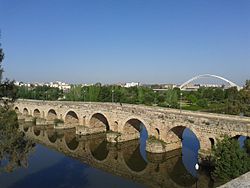Puente Romano (Mérida)
| Puente Romano | |
|---|---|

Puente Romano as seen from Alcazaba of Mérida
|
|
| Coordinates | 38°54′47″N 6°21′03″W / 38.91306°N 6.35083°WCoordinates: 38°54′47″N 6°21′03″W / 38.91306°N 6.35083°W |
| Crosses | Guadiana River |
| Locale | Mérida, Spain |
| Characteristics | |
| Design | Arch bridge |
| Material | Granite ashlar |
| Total length | 790 m (incl. approaches) |
| Width | Ca. 7.1 m |
| Longest span | 11.6 m |
| No. of spans | 60 (incl. 3 buried) |
| History | |
| Construction end | Reign of Trajan (98–117 AD) |
The Puente Romano (Spanish for Roman Bridge) is a Roman bridge over the Guadiana River at Mérida, Spain. It is the world's longest surviving bridge from ancient times, having once featured an estimated overall length of 755 m with 62 spans. Today, there are 60 spans (three of which are buried on the southern bank) on a length of 721 m between the abutments. Including the approaches, the structure totals 790 m. It is still in use, but was pedestrianized in 1991.
Annexed to the bridge is the Alcazaba of Mérida, a Moorish fortification built in 835.
Close to the remains of the Los Milagros aqueduct bridge, there exists another Roman bridge at Mérida, the much smaller Puente de Albarregas.
...
Wikipedia

